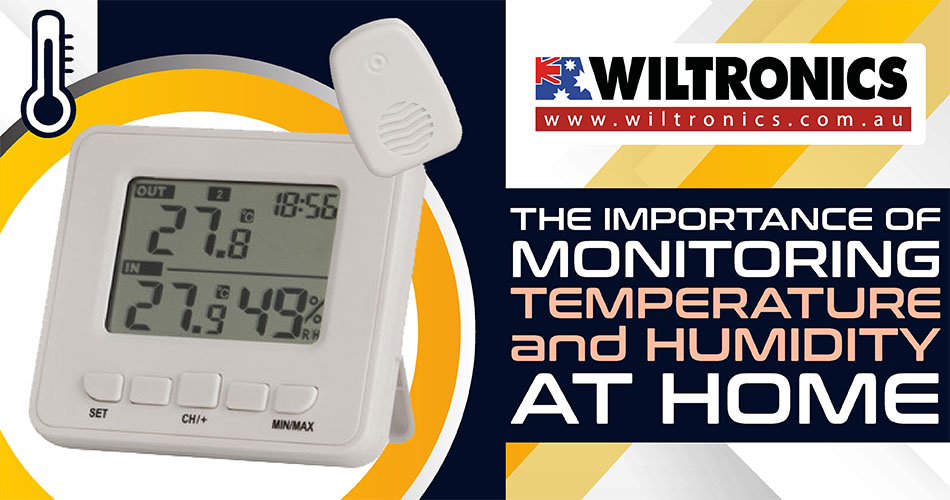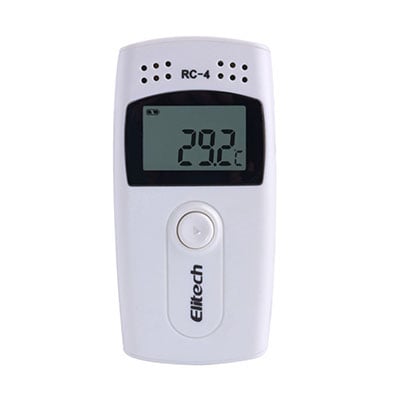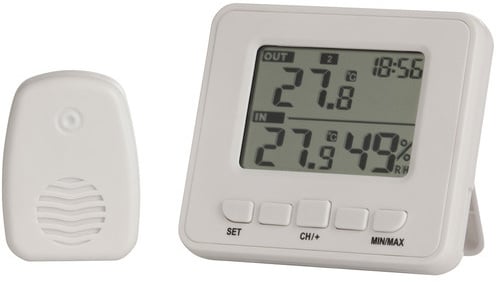The Importance of Monitoring Temperature and Humidity at Home
November 24, 2021

How important do you think monitoring temperature and humidity is?
It’s not a common conversation, especially at home. Truth is, temperature and humidity play a bigger role than you might believe.
To understand why monitoring them is important, you need to learn what both are. This includes how you measure these levels.
In this post, we will answer one of the important questions, and that is: ‘What occurs when a home has too much or too little temperature and humidity?’
Keep reading to know all the answers!
Understanding the Significance of Home Temperature
Generally, we spend about 90% of our days indoors, and most of that is at home. Our ‘Humble abode’ as some call it should be made safe and risk-free.
And given what we have been facing, with the pandemic and climate stresses, ensuring the conditions inside your household is more important than ever. This includes the temperature, which has a more major impact on your everyday life than you may think.
Home temperature is something you have to monitor quite carefully. Just a few degrees can make all the difference; you could be in danger of overheating or shivering.
The best temperature will make your home as comfortable as possible. Check whether some rooms are or should be cooler or warmer than others. You can do this by using a temperature and humidity data logger, which we will talk about more later.
The impact of poor temperature level on your home
There is scientific evidence that certain temperatures can be hazardous for your health. For instance, having your home temperature be too cold can lead to the risk of respiratory illnesses.
This is why your home temperature is something you need to pay especially close attention to. Most importantly if there are any elderly people or babies in your household.
Home temperature also affects your pets. Too warm or too cool temperatures can impact their health too. So be careful and make sure your furry friends have optimal conditions at home.
Moisture, dampness, and mould are other things that home temperature can aggravate. Too cold can lead to dampness and end up causing mould, which induces respiratory symptoms over time.
And when your home is too hot, it can get humid. And that humidity can cause moisture to affect your drywall, doors, and windows.
Lastly, it affects your sleep. When your bedroom is at the right temperature, it makes it much easier to fall asleep and stay asleep. No one wants to wake up in the middle of the night sweating or shivering.
The ideal home temperature
This will depend on the season. But for both comfort and efficiency, the ideal home temperature is between 20°C to 25°C (68°F – 78°F).
In the summer, the recommended thermostat setting is 25°C (78°F). Meanwhile, in the winter, 20°C (68°F) is ideal for energy savings.
However, these temperatures might not be the most ideal in some situations. There are some challenges that homeowners face, such as:
- Humidity. Winter air is naturally dry, causing moisture to evaporate from your skin which makes you feel cold. Then, high humidity in the summer gives off a muggy feeling, making you want to run the AC unit more.
- Home size, layout, and orientation. Suppose you spend a lot of time in the south-facing upstairs office. You may need to set the temperature lower than 25°C to stay comfortable. In contrast, this could make the baby’s north-facing nursery uncomfortably cold.
- Home occupancy and time of day. 20°C in the winter and 25°C in the summer may be comfortable enough while you are at home. But it will be a waste to heat and cool a house when it is vacant.
- Age and health. The young, elderly, and people in poor health, usually prefer warmer temperatures.
How to keep your home comfortable for less? When you are uncomfortable, the easy solution is to change the thermostat setting to suit your needs.
But other methods can help you warm up in the winter and cool off in the summer without increasing your energy bills. One of them is controlling the humidity in your home.
Understanding the Significance of Home Humidity
When talking about humidity, we tend to narrow in on the weather outside. To understand its impact on your home, it is vital to understand humidity at its core.
Humidity is the measure of the moisture vapour level suspended in the air around you. There are primary measurements of humidity and these are: absolute and relative.
The basic reading of humidity is absolute humidity. It measures the amount of water vapour in the air.
In contrast, relative humidity describes the amount of water in the air in relation to the temperature. Considering hot air holds more moisture than cold air, relative humidity at high temperatures is far more noticeable than it is at lower temperatures.
Absolute and relative humidity are not interchangeable terms. Keep in mind that relative humidity has a more profound effect on indoor air quality.
The impact of humidity on indoor air quality
When it comes to the breathability of the air in your home, indoor air quality is the most important factor. If it drops below a certain level, the risk for you and your family to suffer from respiratory problems is higher.
Thus, ignoring the role that humidity plays in your home could lead to serious problems. Pollen, dust, and other contaminants also contribute to poor air quality.
Low humidity is one of the leading causes of ailments developed in the home. It prompts a couple of health problems, such as:
- Dry, cracked skin
- Bloody noses
- Chapped lips
- Dry sinuses
- Asthma
- Bronchitis
Meanwhile, other risks come to the forefront in high humidity. This increases moisture, allowing microorganisms to thrive including:
- Dust mites
- Bacteria
- Mould
If dust mites multiply in bedding and furniture, they can amplify the effects of respiratory issues. While mould and bacteria are also potentially lethal if they snowball and enter the air ducts.
Significance of humidity on your home
Indoor humidity puts your family’s health at risk, and also your home. It wreaks havoc on wood surfaces, particularly when humidity is too low.
When humidity is not up to the right level, cracking or splitting of the wood along the grain begins to occur. Not only does this destroy hardwood flooring and furniture, but it also creates an expensive fix.
For instance, fixing furniture or wood flooring in a dry condition usually requires total replacement. The problem here is that you cannot always tell if your relative humidity is lacking until the damage has been done.
High humidity also has a detrimental effect on your home. But unlike low humidity, it is easier to identify.
If you notice excess moisture pooling on surfaces, and water forming on windows and walls, it could only mean one thing. Your home’s humidity is too high.
Excess moisture causes wood to warp, destroying both engineered and natural hardwood flooring. High humidity can also get into walls and underneath the flooring, causing rot over time.
Considering moisture inside the walls is hard to find, this makes it even more important to monitor your home’s humidity levels.
Identifying poor home humidity levels
Excess moisture on walls and windows can be easy to spot, but other times, it is not so simple. Some signs of poor home humidity levels include:
- Peeling wallpaper or blistering paint
- Water stains on the wall
- Visible growth of mould in usual low-moisture areas
- A musty odour in crawl spaces, the basement, or when turning on your AC unit
And one interesting sign of low home humidity is an increase in static electricity. Plus, frequent problems with appliances and other household electronics.
The ideal home humidity
The perfect home humidity is not always easy to pinpoint. For one, it relies on personal tastes and outdoor temperatures.
But ideally, home humidity should stay between 30% to 40% in the winter months. Meanwhile, summer allows a bit higher rate from 40% to 60%.
What increases this problem is that you have to constantly watch your humidity as outdoor temperatures change.
What Can You Do?
Now you know the importance of monitoring temperature and humidity, what is next? What can you do about them?
If you find that your home has issues getting to or staying at your ideal temperature, it may be time for an upgrade. Making sure your home is well-insulated helps.
Another great option is to get a programmable thermostat installed in your home. This will give you more control over the home temperature.
And to get the perfect balance of indoor humidity in your home, consider getting a humidifier or dehumidifier. A smart thermostat can also help you assess the air in your home to understand humidity levels.
Speaking of temperature and humidity thermometers, check out our amazing offers below!
Monitoring Temperature and Humidity: Data Loggers
Keeping an eye on and monitoring temperature and humidity at home is a great practice. Do it with ease with these temperature and humidity Monitors!

1. Temperature and Humidity Datalogger USB
Product code: ME6000
This temperature and humidity data logger USB comes with an external temperature probe. It features a high precision sensor and an over-limit buzzer alarm.
Power is provided by an included CR2450 battery or via USB cable. Even better, the datalogger can generate four kinds of reports: Word, Excel, PDF, as well as txt files.
2. USB Temperature and Humidity Data Logger
Product code: JXC0424 – No longer available
Looking for an easy to use temperature and humidity data logger? This electronic device might be the one you are looking for!
This data logger is easy to use and is water-resistant, ideal for both indoor and outdoor use. It features big buttons with an LCD display to easily change your settings.
Once connected to a computer via USB, the supplied software can read the logged data and export it in graphs or CSV files.

3. Wireless In & Out Thermometer and Hygrometer
Product code: JXC0322
This model is so advanced that it is capable of measuring indoor and outdoor temperature, as well as relative indoor humidity. The large easy-to-read LCD acts as a receiver unit for a separate outdoor sensor unit.
It will record max and minimum temperatures for quick referral and conveniently displays the time of day. The LCD receiver unit is also capable of receiving information from up to 3 sensor units, which are available separately: see JXC0324.
Monitoring Temperature and Humidity: The Bottom Line
See how important monitoring temperature and humidity are at home? We hope this guide will help you make sure both stay under control under your roof!
Regular cleaning and investing in the right temperature and humidity data logger or thermometer can help make everyone in your home more comfortable and healthier.
May you and your family enjoy perfect indoor air quality all year long!
© Wiltronics Research Pty Ltd 2021
Write a Comment
You must be logged in to post a comment.